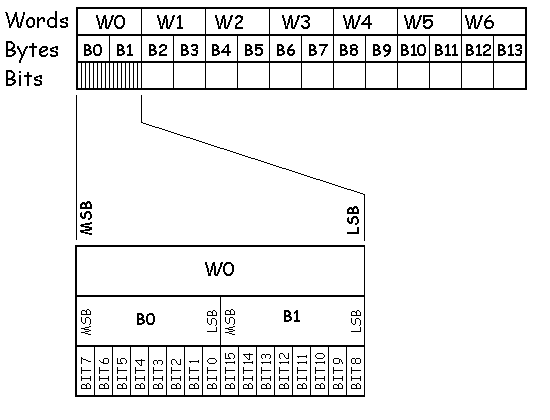| W 0 | W 1 | W 2 | W 3 | W 4 | W 5 | W 6 | |||||||
| B 0 | B 1 | B 2 | B 3 | B 4 | B 5 | B 6 | B 7 | B 8 | B 9 | B 10 | B 11 | B 12 | B 13 |
B0 to B13 are Byte variables (8 bits), and W0 to W6 are Word variables (16 bits).
The RAM available to the programmer of the '08 is 14 Bytes, or 7 Words, or a combination of these. Note that the Word variables and the Byte variables are overlaid, so writing a word to, say, W 4, results in variable B 8 & B 9 being occupied by the upper and lower bytes of the Word variable.
Also, the first Word (W0) is accessable as 16 bits of bit-memory, with the first Byte (B0) split into the first 8 Bits (BIT0, BIT1, BIT2, BIT3, BIT4, BIT5, BIT6, BIT7) and the next Byte (B1) split into the final 8 bits (BIT8 to BIT15).
| W0 | |||||||||||||||
| B0 | B1 | ||||||||||||||
| BIT7 | BIT6 | BIT5 | BIT4 | BIT3 | BIT2 | BIT1 | BIT0 | BIT15 | BIT14 | BIT13 | BIT12 | BIT11 | BIT10 | BIT9 | BIT8 |
the use of the keyword symbol is a good idea...
Let b0 = 3 'assigns the value of 3 to the variable b0 |
Now lets show a few more things...
Let b0 = 0 'assigns the value of 0 to the variable b0 |

Copyright © 2008- Ted J. Mieske
All Rights Reserved.